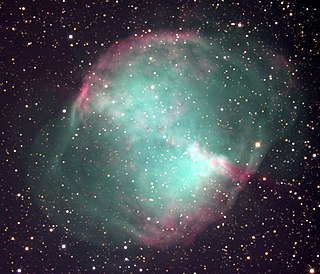
The Dumbbell Nebula is a planetary nebula in the constellation Vulpecula, at a distance of about 1360 light-years. It was the first such nebula to be discovered, by Charles Messier in 1764. At its brightness of visual magnitude 7.5 and diameter of about 8 arcminutes, it is easily visible in binoculars and is a popular observing target in amateur telescopes.

The Eskimo Nebula, also known as the Clown-faced Nebula, Lion Nebula, or Caldwell 39, is a bipolar double-shell planetary nebula (PN). It was discovered by astronomer William Herschel in 1787. The formation resembles a person's head surrounded by a parka hood. It is surrounded by gas that composed the outer layers of a Sun-like star. The visible inner filaments are ejected by a strong wind of particles from the central star. The outer disk contains unusual, light-year-long filaments.

The Little Dumbbell Nebula, also known as Messier 76, NGC 650/651, the Barbell Nebula, or the Cork Nebula, is a planetary nebula in the northern constellation of Perseus. It was discovered by Pierre Méchain in 1780 and included in Charles Messier's catalog of comet-like objects as number 76. It was first classified as a planetary nebula in 1918 by the astronomer Heber Doust Curtis. However, others might have previously recognized it as a planetary nebula; for example, William Huggins found its spectrum indicated it was a nebula ; and Isaac Roberts in 1891 suggested that M76 might be similar to the Ring Nebula (M57), as seen instead from the side view.

NGC 7027, also known as the Jewel Bug Nebula, is a very young and dense planetary nebula located around 3,000 light-years from Earth in the constellation Cygnus. Discovered in 1878 by Édouard Stephan using the 800 mm (31 in) reflector at Marseille Observatory, it is one of the smallest planetary nebulae and by far the most extensively studied.
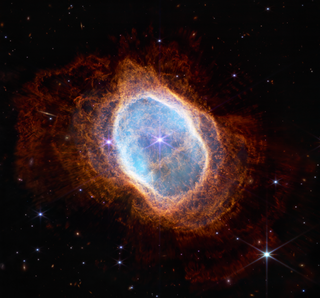
NGC 3132 is a bright and extensively studied planetary nebula in the constellation Vela. Its distance from Earth is estimated at about 613 pc or 2,000 light-years.

NGC 6302 is a bipolar planetary nebula in the constellation Scorpius. The structure in the nebula is among the most complex ever observed in planetary nebulae. The spectrum of NGC 6302 shows that its central star is one of the hottest stars known, with a surface temperature in excess of 250,000 degrees Celsius, implying that the star from which it formed must have been very large.

NGC 2022 is a planetary nebula in the equatorial constellation of Orion, located at a distance of 8.21 kilolight-years from the Sun. It was first observed by William Herschel on December 28, 1785, who described it as: considerably bright, nearly round, like a star with a large diameter, like an ill-defined planetary nebula. In medium-sized amateur telescopes it looks like a small grayish patch of light. It is not very bright but it is still easy to spot it in the eyepiece. Even in a telescope as small as 80mm it can just be seen using a narrowband filter such as an OIII filter as a 'fuzzy' star. The object has the shape of a prolate spheroid with a major to minor axis ratio of 1.2, an apparent size of 28″, and a halo extending out to 40″, which is about the angular diameter of Jupiter as seen from Earth.

NGC 3918 is a bright planetary nebula in the constellation Centaurus, nicknamed the "Blue Planetary" or "The Southerner". It is the brightest of the far southern planetary nebulae. This nebula was discovered by Sir John Herschel in March 1834 and is easily visible through small telescopes. The round or even slightly oval diameter is telescopically between 8 and 10 arcsec, though deep images extends this to about 19 or 20 arcsec. More surprising is the beautiful rich blue colour that looks much like the coloured images of Neptune taken by Voyager 2 in 1989.
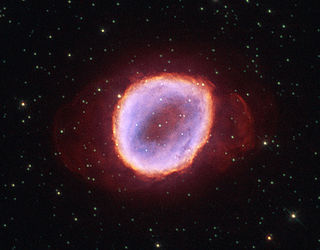
NGC 6565 is a planetary nebula in the constellation of Sagittarius. The object formed when a star ejected its outer layers during the late stages of its evolution. The remnant core of the star, a white dwarf, is emitting vast amounts of ultraviolet radiation that ionizes, or excites, the gas surrounding it, making the nebula visible to the human eye through a telescope. Over the course of around 10,000 years the white dwarf will cool down dramatically, diminishing the light of the nebula and making it only visible in a long-exposure photograph.
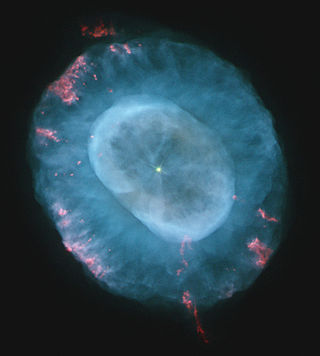
NGC 7662 is a planetary nebula located in the northern constellation Andromeda. It is known as the Blue Snowball Nebula, Snowball Nebula, and Caldwell 22. This nebula was discovered October 6, 1784 by the German-born English astronomer William Herschel. In the New General Catalogue it is described as a "magnificent planetary or annular nebula, very bright, pretty small in angular size, round, blue, variable nucleus". The object has an apparent visual magnitude of 8.3 and spans an angular size of 32″ × 28″. Parallax measurements give a distance estimate of 5,730 ± 340 ly (1,757 ± 103 pc).
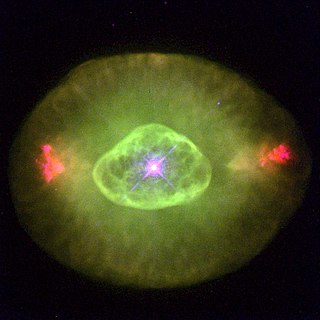
NGC 6826 is a planetary nebula located in the constellation Cygnus. It is commonly referred to as the "Blinking Planetary", although many other nebulae exhibit such "blinking". When viewed through a small telescope, the brightness of the central star overwhelms the eye when viewed directly, obscuring the surrounding nebula. However, it can be viewed well using averted vision, which causes it to "blink" in and out of view as the observer's eye wanders.
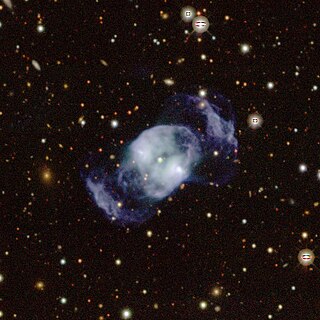
NGC 2371-2 is a dual lobed planetary nebula located in the constellation Gemini. Visually, it appears like it could be two separate objects; therefore, two entries were given to the planetary nebula by John Louis Emil Dreyer in the New General Catalogue, so it may be referred to as NGC 2371, NGC 2372, or variations on this name. It has also been called the double bubble nebula.

NGC 3242 is a planetary nebula located in the constellation Hydra.

The Little Gem Nebula or NGC 6818 is a planetary nebula located in the constellation of Sagittarius. It has magnitude 10 and oval diameter of 15 to 22 arcseconds with a 15th magnitude central star.
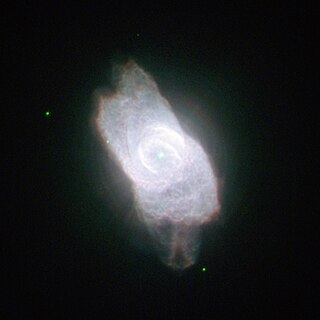
NGC 6572 is a planetary nebula with magnitude 8.1, easily bright enough to make it an appealing target for amateur astronomers with telescopes. NGC 6572 is a young planetary nebula. NGC 6572 began to shed its gases a few thousand years ago. Because of this, the material is still quite concentrated, which explains its abnormal brightness. The envelope of gas is currently racing out into space at a speed of around 15 kilometres per second. As it becomes more diffuse, it will dim. It is located within the large constellation of Ophiuchus and at low magnification, it will appear to be just a colored star, but higher magnification will reveal its shape. NGC 6572 was discovered in 1825 by the German astronomer Friedrich Georg Wilhelm von Struve. According to several sources such as Sky & Telescope, this object received the nicknames Blue Racquetball, Emerald Nebula, Green Nebula, Turquoise Orb.

NGC 6309, also known as the Box Nebula, is a planetary nebula located in the constellation Ophiuchus. It was discovered by the German astronomer Wilhelm Tempel in 1876. It has a luminosity of about 1800 times that of the Sun. The distance to this nebula is not well known, but it is assumed to be about 6,500 light-years or 2,000 parsecs.

NGC 7329 is a large barred spiral galaxy located in the constellation Tucana. NGC 7329 was discovered by British astronomer John Herschel in 1835.
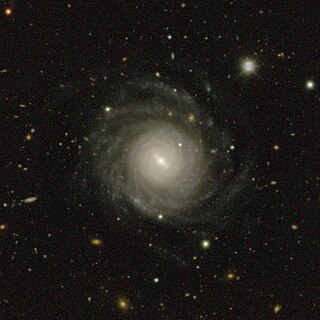
NGC 626 is a very large barred spiral galaxy located in the constellation Sculptor. Its speed relative to the cosmic microwave background is 5,475 ± 16 km/s, which corresponds to a Hubble distance of 80.8 ± 5.7 Mpc. NGC 626 was discovered by British astronomer John Herschel in 1834.
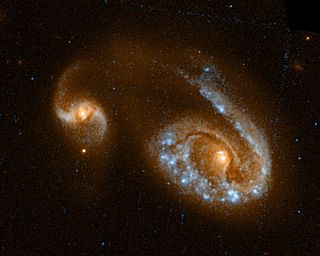
NGC 5278 is a spiral galaxy in the constellation Ursa Major. It was discovered by German-British astronomer William Herschel in 1789. NGC 5278 is in gravitational interaction with the galaxy NGC 5279. This pair of galaxies appears in the Halton Arp's Atlas of Peculiar Galaxies under the symbol Arp 239. The luminosity class of NGC 5278 is II. The nucleus of this galaxy presents a burst of star formation and it is an active Seyfert 2 type galaxy. In addition, NGC 5278 is possibly a LINER galaxy, a galaxy whose nucleus presents an emission spectrum characterized by broad lines of weakly ionized atoms. NGC 5278 is also a galaxy whose core shines in the ultraviolet spectrum. It is listed in the Markarian catalog under the reference Mrk 271.

NGC 6563 is a planetary nebula in the constellation Sagittarius. NGC 6563 was discovered by Scottish astronomer James Dunlop in 1826. Detailed studies on NGC 6563 have been conducted, although not much specific information about the nebula is known.





















